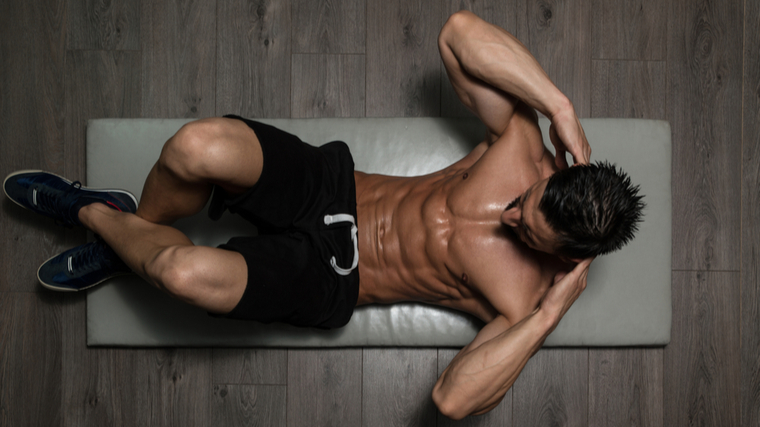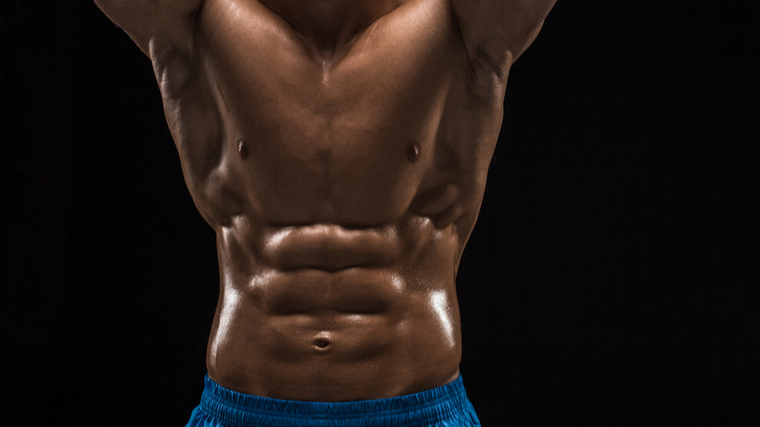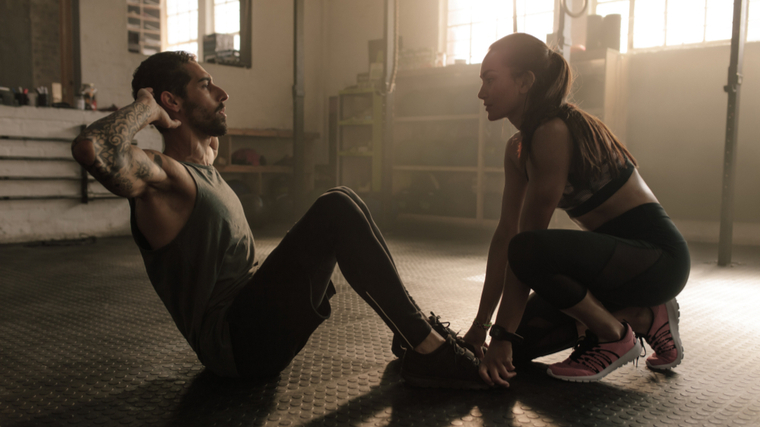There are two warring factions that constantly struggle to claim dominance over the core training conversation, even in bodybuilding.
The “squats are all you need” crowd, whose ethos is based on big compound movements being the endgame of exercise — and the “isolate everything” people, who would not dream of going through an ab workout with any less than four variations of the sit-up to ensure optimal abdominal development.

If you’re after a rock-solid midsection that looks good on the beach, or you’re prepping for your first appearance on the bodybuilding stage, you can’t have your path clouded by maybes and mysticism.
You need core workouts that work, no matter if you’re new to the gym or are a seasoned veteran. Here are three different ways to tackle your next ab day, tuned just right for your experience level.
Best Bodybuilding Ab Workouts
- Beginner Ab Workout for Bodybuilding
- Intermediate Ab Workout for Bodybuilding
- Advanced Ab Workout for Bodybuilding
- Home Ab Workout for Bodybuilding
Editor’s Note: The content on BarBend is meant to be informative in nature, but it shouldn’t take the place of advice and/or supervision from a medical professional. While many of our contributors and Experts have respected certifications and degrees, and while some are certified medical professionals, the opinions and articles on this site are not intended for use as diagnosis and/or treatment of health problems.
Beginner Ab Workout for Bodybuilding
Your abs are put through the ringer during your early days in the gym. Whether you like it or not, they’re forced to stabilize your trunk while you learn to press, pull, row, hinge, and everything in between.
Therefore, you don’t need to give them too much focused attention early on. You can attach a couple of smart core exercises to the tail end of your lower-body workouts and make gains just fine.
The Workout
You’ll find you get plenty of core activation during your squats, deadlifts, and single-leg work when you’re new to the gym. Since one of your core’s major jobs is stabilizing against external forces, your isolation work should reinforce that quality early on to help build a stable and reliable base long-term.
- Bear Plank or Bird Dog: 2×20 seconds
- Hanging Leg Raise or Jackknife: 2×15
How to Progress
Since there’s no magic bullet for a killer core, you can pick your exercise of choice early on when just about anything works for hypertrophy. Do what’s comfortable. To progress your two movements, simply focus on racking up more total time spent performing the exercise.
Even without external load, beginner lifters are sensitized enough to training that you can make some ab gains without ever picking up a weight if you like.
Intermediate Ab Workout for Bodybuilding
After a couple of years of training, you might find that your core can withstand just about any physical task you throw at it, like trying for a new deadlift personal record. However, your abs might not “pop” like you want them to.
If that’s the case, it’s time to give your abs some dedicated attention.
The Workout
When it comes time to beef up your ab workouts, you’ll have to seek out some external resistance if you want to continue to make progress. Calisthenics are all well and good, but you’ve probably noticed how quickly you adapt to unloaded work. If it’s too easy, it’s not helping you make gains.
- Cable Crunch: 3×12-15
- Dumbbell Side Bend: 2×12-15
- Weighted Plank: 3×30 seconds
- Bicycle Kick: 2×45 seconds
How to Progress
Each of these four movements cover a different primary function of your core. On the cable crunches and side bends, look to add weight where possible. If you’re capped out on resistance, try to reduce your downtime between sets.
For the planks and bicycle kicks, density is the name of the game. If you can hit your time target comfortably, reduce how long you rest between sets.
Advanced Ab Workout for Bodybuilding
After many years in the gym, you might find that your muscles simply don’t grow as readily as they once did. Or, you’ve foolishly neglected your midsection for too long and now your abs don’t match up to the rest of your physique.
In either case, the solution is the same — dig into a truly grueling abdominal workout worthy of a ten-year gym veteran.
The Workout
To make ab gains after you’ve been in the gym awhile, you need to pull out all the stops. This means relying on both standard resistance-based overload as well as some fancy training techniques and endurance work to boot.
- Bird Dog: 2×10 reps as a warm-up
- Cable Crunch superset Plank: 3×15 + 30 seconds
- Hanging Leg Raise superset Medicine Ball Slam: 3×15 + 10
- Russian Twist: 2×10-12 per side
- Single-Arm Carry: 3 rounds of 20 paces
- Crunch: 100 reps in as few sets as possible
How to Progress
As an advanced physique athlete, you need to squeeze out gains wherever you can find them. You may have exhausted your potential to repeatedly add weight to your lifts on a weekly basis, but that doesn’t mean you shouldn’t try on exercises like the cable crunch, Russian twist, or leg raise.
For the non-loaded movements, don’t be afraid to train to failure. You’ll need to take your core to the brink if you want to make visible changes to your physique.
Home Ab Workout for Bodybuilding
It’s not always realistic to get to the gym after a long day at the office. Or, you may be part of the “I’ll just do abs at home” crowd. Either way, you can still develop your core right from the convenience of your living room.
The Workout
Without access to a cable machine or heavy weights, you’ll need to rely on mostly bodyweight movements. This also means not being shy about taking yourself to true failure and working harder — and longer — than you might be used to.
Perform these movements as a circuit back-to-back with little to no rest between exercises.
- Weighted Plank: 20 seconds
- Bird Dog: 10 reps per leg
- Toe Taps: 30 reps total
- Bicycle Kick: 20 seconds
- Side Plank: 20 seconds per side
How to Progress
Regrettably, there isn’t a lot in the way of potential progress to be made when you’re only working with your body weight. Not in the traditional sense, at least.
If the circuit above is too easy, you can increase the duration of each movement. You can also increase your volume by performing extra rounds, or your frequency by hitting this workout up as often as thrice per week.
Alternatively, you can even look to replace the moves with similar but more challenging variations. The long lever plank for the bird dog, the V-up for the bicycle kick, etc.
Anatomy of the Core
A common rookie mistake in bodybuilding is assuming your core is all about your six-pack. While your abdominals do steal the show on the bodybuilding stage, your core is a 360-degree machine. You need to know its ins and outs if you want to train it properly.
Rectus Abdominis
Your rectus abdominis is the long, vertical sheet of muscle that runs from your sternum to your groin. It’s the main muscle that makes up the ever-sought-after six pack. The rectus abdominis attaches from your ribcage to your pelvis and serves to bend the trunk — as well as resist unwanted bending.
Obliques
The oblique muscles sit on the side of your torso and assist the rectus abdominis in performing anatomical functions like frontal and lateral flexion. Although there are two distinct compartments, the external and internal obliques, there isn’t much in the way of practical relevance for training purposes there.

Exercises that contain (or resist) twisting motions will bias your obliques to a significant degree.
Erector Spinae
Although you may not think of it as a core muscle at a glance, your lower back is absolutely considered a part of your core. The erector spinae muscle lies directly above your buttocks and performs many of the opposing functions of the anterior abdominals.
While your rectus abdominis bends your torso over, your erector spinae straightens things back out. You can target your lower back with exercises like the back extension, deadlift, or good morning if you want to make some specific gains in that area.
Extra Credit Muscles
Your torso is chock full of tiny muscles that contribute to your performance. Your transverse abdominis, which sits underneath the abs proper. Your serratus anterior, the egg-shaped muscle that runs up under your pecs. Even your diaphragm plays into how your core works as a unit.
When it comes to training decisions, many of these tiny muscles aren’t worth much consideration as you can’t reliably isolate or develop them without involving your abs, obliques, or lower back in the first place.
Six-Pack Science
There may not be a more hotly-contested area of bodybuilding than ab training. A tight, well-developed core transcends the insular culture of competitive physique development — your average Joe or Jane wants a trim tummy too.
As such, there’s more than a little misinformation floating around about core training and what actually works. Luckily, scientific literature lights the way.
Is Ab Training Dangerous?
You might’ve heard that crunches or sit-ups on the floor — the biomechanical motion of spinal flexion — are somehow dangerous for your back. Fortunately, this idea isn’t really corroborated in the literature.
As long as you don’t have any preexisting conditions or contraindications from a qualified medical professional, spinal flexion, even under light loading, isn’t particularly injurious. (1)
Do You Need to Isolate?
Some say you need to crunch, twist, or plank your way to a six pack. Others say exactly the opposite — heavy squats and pulls are all you need and then some.
When it comes to strength and performance, the literature indicates that you may not necessarily need to include specific core exercises if your training goals don’t require a shredded midsection. (1)
That said, isolation work is invaluable for developing specific musculature, and the abs are no exception. If you want a well-developed core, you should give it some dedicated time.
Do You Need to Use Weights?
Strictly speaking, no. You can build up your abs without ever touching a dumbbell or weight plate. That doesn’t mean it’ll be easy, convenient, or optimal, though.
Your core muscles are just like any other tissue in your body. Eliciting hypertrophy is as simple as applying progressive tension and being patient (along with eating well).

You don’t necessarily need external load to challenge your core — for example, placing your forearms further from your body during a plank will make the exercise much more difficult and increase abdominal activation as well. (2)
Upping the ante on bodyweight work isn’t always that simple, though. High-level bodyweight movements take time to master and require a good bit of stability, which may detract from your goal of hypertrophy. Working with weights isn’t the only way, but it is the most reliable and consistent for encouraging growth.
Are Squats and Deadlifts Enough?
Research seems to indicate that if you want to develop a remarkable set of abs, you may have to depart the squat rack — at least for a little while. Heavy squatting and deadlifting does indeed require a good deal of isometric core strength, similar to what you’d get from a weighted plank.
As a bonus, some literature has actually shown that wearing a lifting belt does more for your abs when you squat or pull. (3)
For hypertrophy specifically, the bulk of your training should involve both concentric and eccentric contractions to create the most muscle damage. Isometric work is all well and good, but it shouldn’t make up the entirety of your ab workout.
The Big Picture
If you’re aiming for a physique that turns heads, you can’t neglect your core. It can be all too easy to put ab work aside if you’re strapped for time in the gym or are feeling a bit demotivated during your workouts.
Even though a shredded midsection is revealed in the kitchen, it is built in the gym. If you’re trying to lose fat for the summer and reveal your abs, you don’t want to grind away for months only to have little muscularity to show for it.
So, make ab work a priority. You’ll have to get out of the squat rack, get comfy with cables, and probably do a bit more bodyweight training than you might be used to. But, not only will you be working towards a chiseled core, ab training will serve you well when it comes time to test your strength.
References
1. Contreras, Bret & Schoenfeld, Brad. (2011). To Crunch or Not to Crunch: An Evidence-Based Examination of Spinal Flexion Exercises, Their Potential Risks, and Their Applicability to Program Design. Strength & Conditioning Journal. 33. 8-18. 10.1519/SSC.0b013e3182259d05.
2. Schoenfeld, B. J., Contreras, B., Tiryaki-Sonmez, G., Willardson, J. M., & Fontana, F. (2014). An electromyographic comparison of a modified version of the plank with a long lever and posterior tilt versus the traditional plank exercise. Sports biomechanics, 13(3), 296–306.
3. Escamilla, R. F., Francisco, A. C., Kayes, A. V., Speer, K. P., & Moorman, C. T., 3rd (2002). An electromyographic analysis of sumo and conventional style deadlifts. Medicine and science in sports and exercise, 34(4), 682–688.
Featured Image: Jasminko Ibrakovic / Shutterstock